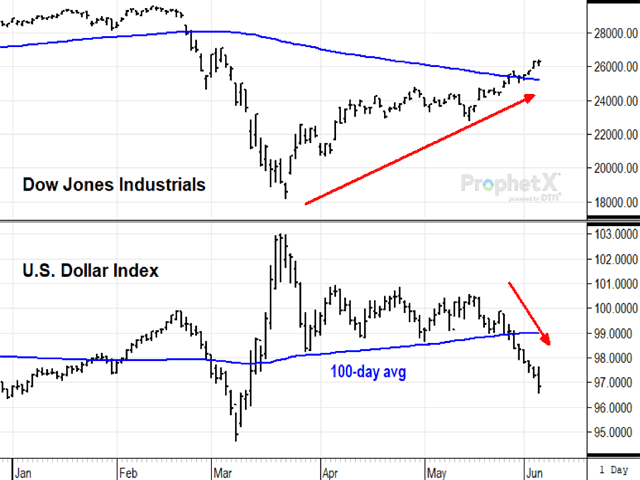Todd's Take
This Is What a Recovery Looks Like
Hindsight is a wonderful thing. Any of us can pick up a chart and say "oh, we should have bought here and sold there," but few of us -- maybe none of us -- actually do it in real time. I find the disconnect fascinating between what we should have done and what we actually did because it points out how difficult it is to see events clearly as we trudge through life moment by moment.
I was reminded of that again Monday (June 1) as rumors about China were being tossed around. Soybeans traded higher Sunday night after President Donald Trump didn't bring up the phase-one agreement in his Friday afternoon news conference.
Early Monday, Reuters reported China had put out the word for state firms to stop buying U.S. soybeans and pork, based on "two sources familiar with the matter." Bloomberg news released a similar story, based on "people familiar with the situation."
The unnamed sources didn't seem to deter anyone, and other media outlets were soon repeating the same reports. As I write this four days later, it is still not known if the original report was true, poor journalism, Chinese misinformation or completely bogus.
At DTN, we strain to give our readers accurate market coverage, and when sources are not identified, our analysts are instructed to make that clear in market comments. We feel obligated to mention rumors that affect prices, but also try to stress the information is based on unconfirmed sources. Mentioning rumors doesn't mean we like them and we certainly don't advocate making risk management decisions or trades based on rumors.
I wasn't working in the newsroom in the 1980s, but I was working as a commodity broker and recall customers frequently coming into the office with hot tips they heard from a friend of a friend.
P[L1] D[0x0] M[300x250] OOP[F] ADUNIT[] T[]
Typically, the sources traced back to someone in Chicago, not much different from the "people familiar with the matter" we read about these days. For some unexplainable reason, we seem to be attracted to the lure of a special secret that nobody else knows -- or so we want to believe.
As you probably guessed, I don't recall anyone making money on inside tips back then and I doubt the odds have gotten any better since. As I told customers then, and I'm happy to repeat now, you don't have to rely on hearsay to make good trading decisions -- the market is full of legitimate clues to help us out.
I am glad to report this week, there are several signs of improving economic conditions. On Wednesday (June 3), ADP reported the U.S. lost 2.76 million private sector jobs in May, much less than expected. According to CNBC.com, Mark Zandi, the chief economist at Moody's Analytics now expects job growth to resume in June.
The U.S. dollar index has also been a marker of easing coronavirus concerns. Investors seeking safe haven pushed the dollar to a three-year high on March 20, but are now feeling less anxious as investors have turned into sellers, sending prices to a new two-month low Thursday.
For ag commodities, specific signs of higher demand are being seen in weekly statistics of rising fuel demand, a restoration of the livestock slaughter pace and in commodity prices themselves. Wednesday's report from the U.S. Energy Department showed last week's ethanol production at 765,000 barrels per day, up from a low of 537,000 barrels per day in late April. Ethanol inventory is back down to its lowest level since early January.
Ethanol production is still down 27% from a year ago, but spot ethanol prices are up 44% from their April 1 low and July RBOB gasoline prices have more than doubled since hitting their low on March 23.
In the livestock sector, coronavirus outbreaks are still a threat at meat plants and euthanization of hogs and poultry is still a concern. However, the increases in slaughter rates since early May have been impressive. USDA estimated Thursday's cattle slaughter at 117,000, within 5,000 head of a year ago. Hog slaughter was estimated at 437,000, down 7% from a year ago.
Granted, July corn has been slow off the mark, but last week's new one-month high in the July contract was a good start and any push higher from present levels will offer a challenge to the heavy net short positions held by futures funds.
July soybeans posted a new one-month high Thursday and turned the stochastic indicator bullish on the weekly chart for the first time in 2020. Roughly two weeks earlier, July soybean oil also posted a new one-month high, encouraged by a gradual rise in palm oil prices.
I point all this out because it's easy to get distracted by the rumors of the day and miss the more obvious evidence of what is already happening around the markets.
Pertaining to the coronavirus, no one can say for sure what autumn and winter will bring, but for now, there is plenty of evidence showing prices benefiting from increased demand. Rumors come and go, and my advice is to let them go. The market has more important messages that deserve our attention.
Todd Hultman can be reached at Todd.Hultman@dtn.com
Follow him on Twitter @ToddHultman
(c) Copyright 2020 DTN, LLC. All rights reserved.




